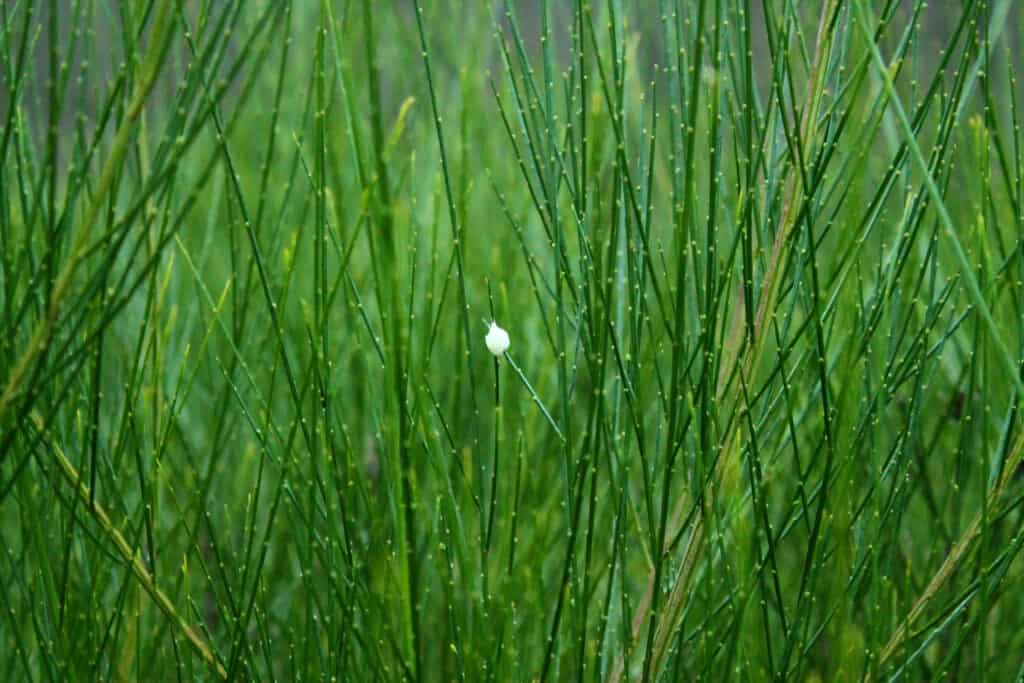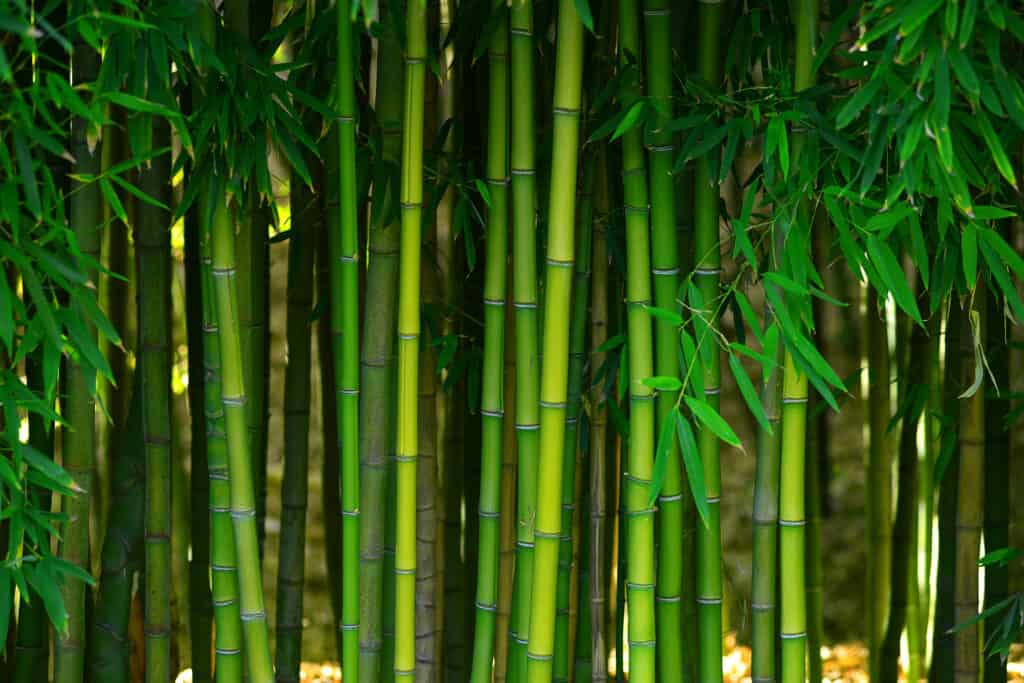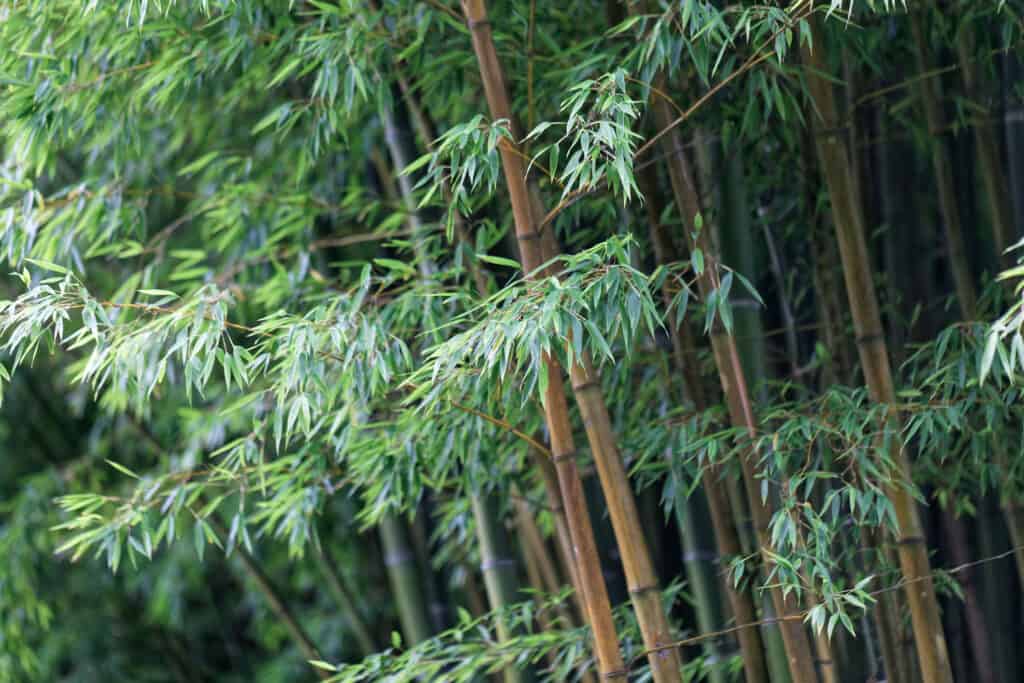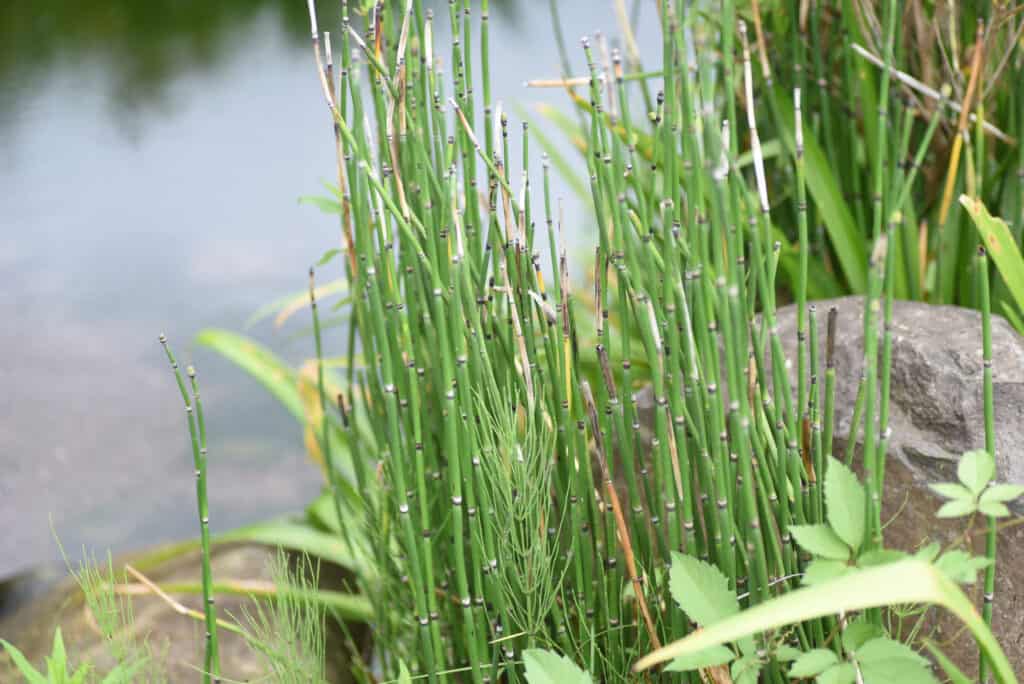If you’re interested in evergreen, water-loving plants, you may be wondering what the differences and similarities are of horsetail vs. bamboo. While these popular ornamental plants have some structural overlaps, they belong to entirely separate plant orders and have several distinct characteristics and growing habits.
In this guide, we’ll discuss all things horsetail vs. bamboo, including their classification, physical characteristics, native ranges, ideal growing conditions, and uses. So, without further ado, let’s jump in!
Horsetail vs. Bamboo: A Quick Look
| Horsetail | Bamboo | |
|---|---|---|
| Plant Classification | Equisetum spp. | Bambusoideae |
| Plant Characteristics | Some characteristics of this genus vary by species. All have jointed, hollow stems with long, branching, needle-like bristles spreading outward from the main stem. The leaves of horsetail are barely visible and located around each joint of the stem. Plant stems tend to have almost rubbery appearance. Height at maturity can vary significantly by species from 8 inches to 15 feet. This plant is a non-flowering evergreen perennial. | Subfamily of evergreen flowering perennial grass. All have jointed hollow culms that produce thin, leafing stems. Height and width of culms vary significantly by species and can range from a height of 3 feet to over 100 feet. Colors of culms include blue-grey, black, yellow, red, and various shades of green. |
| Native Range and Ideal Growing Conditions | As a genus, horsetails are native to Africa, Asia, Europe, and the Americas. Specific species have more limited ranges. Horsetails are water-loving plants that require significant moisture retention in the soil to thrive. They can grow in full to partial sun. Prefers slightly acidic soil. Spreads rhizomatically. Part of wetland and boggy ecosystems. | As a subfamily, bamboo is native to parts of Africa, Asia, and the Americas. Native ranges vary widely by species. Bamboo is water-loving with some species able to grow in standing water. Others require moist, but well-draining soil to thrive. They typically prefer loamy, slightly acidic soil. Can grow in full sun to part shade. |
| Uses | Historically used medicinally as a diuretic and anti-inflammatory agent. Current research confirms above-mentioned effects of some species of horsetail. | People have used bamboo extensively for thousands of years. Depending on species, applications include culinary, construction, weapons, instruments, furniture, jewelry, and fabrics. |
Plant Classification
Comparing horsetail vs. bamboo, these water-loving plants share some similar structural characteristics, and both belong to the plant kingdom, but they are members of entirely separate botanical divisions.
Horsetail (Equisetum spp.) is a genus of ancient non-flowering (gymnosperms), evergreen perennial plants that covered the landscape of Earth over 250 million years ago. Flowering plants, or angiosperms, did not come onto the scene until about 125 million years ago. With the rise and spread of flowering plants across the globe for the last 125 million years, the variety of horsetail species has decreased from its previous diversity during its height in the Paleozoic era. Today, this genus contains less than 100 species.
Bamboo (Bambusoideae) is a large, highly diverse subfamily of the grass family (Poaceae). There are three main types of bamboo and over 1,060 species. The three main types, or tribes, of bamboo, are herbaceous bamboos (Olyreae), tropical woody bamboos (Bambuseae), and temperate woody bamboos (Arundinarieae).

Horsetail is a genus of ancient non-flowering, evergreen perennial plants that covered the landscape of Earth over 250 million years ago.
©iStock.com/Wirestock
Horsetail vs. Bamboo: Plant Characteristics
While horsetail and bamboo share some similar structural characteristics, they are still easily distinguished from one another. The main overlap between these two types of plants is their jointed, hollow stems. On bamboo, this stem is referred to as the culm. The stems of these plants appear segmented with joints that separate hollow sections of the stem. As rhizomatic plants – that is, plants that form colonies and spread via shoots from hardy underground horizontal stem structures – both plants produce somewhat similar-appearing shoots when young.
Overall, however, these plants produce distinct characteristics and can reach vastly different maximum heights and diameters.
While the physical characteristics of horsetail differ depending on the species, the horsetail genus shares some key features. Horsetails have upright, hollow, jointed stems with minuscule, flattened leaves attached to the joints. Thin, needle-like branches extend out from the main hollow stem. Some species have more curled branches while others have more feather-like branches. Height at maturity of horsetail can vary significantly by species, and ranges from 8 inches to 15 feet.
Notably, Bambusoideae includes over 1,600 species of bamboo. These plants are flowering, evergreen grasses that can reach heights of over 100 feet tall with culm width of up to 15 inches. On the opposite end are much smaller species that reach heights of only 3 feet and culm diameters of a couple of inches.
Some species, such as one of the most popular timber bamboo species, Phyllostachys edulis, produces straight culms with little branching and large, strong culms. Other species, such as the Appalachian native bamboo, Arundinaria appalachiana, are bushy with slender culms and lots of evergreen leaves. The color of bamboo culms ranges widely and includes yellow, black, grey, grey-blue, red, and various shades of green. Culms can also be striped or spotted.

There are more than 1,600 species of bamboo, some reaching heights of over 100 feet tall.
©iStock.com/p-orbital
Horsetail vs. Bamboo: Native Ranges and Ideal Growing Conditions
Both the horsetail genus and bamboo subfamily enjoy a widespread native range. You can find species of horsetail in Asia, Africa, Europe, and the Americas, while various species of bamboo grow natively in parts of Asia, Africa, and the Americas.
While both plants are water-loving and require high moisture content in the soil to thrive, certain species of horsetail can happily grow in standing water, while bamboo suffers from root rot if the soil is too water-logged.
Generally, horsetail plants can grow in full to partial sun and prefer slightly acidic soil with a high moisture content. You can often find them growing in wetlands and bogs.
While bamboo often grows near water, they actually don’t tend to fare well growing in standing water. Their ideal soil type is loamy, slightly acidic soil that drains well but has a high moisture content. Depending on the species, bamboo can grow in full sun to partial shade.
These plants are not particularly drought tolerant and can suffer significant leaf damage in high winds. Their frost tolerance varies widely by species. If a culm is damaged or destroyed, as long as the rhizome of the plant is unharmed, it will produce more shoots in the Spring. Also, bamboo culms grow to their maximum height in one three to the four-month growing season. Surprisingly, yes, that includes bamboo varieties that can reach over 100 feet in height! That means some species of bamboo can grow over 1 foot per day!

One of the most popular timber bamboo species,
Phyllostachys edulis,produces straight culms with little branching.
©iStock.com/weisschr
Horsetail vs. Bamboo: Uses
In terms of human use, both horsetail and bamboo have been used for various applications by people for thousands of years.
Historically, people have used horsetail for anti-inflammatory and diuretic purposes. Current research does suggest active chemicals in some species of horsetail have anti-inflammatory and diuretic effects. Folkloric medicine also recommends using horsetail’s notably high silica content for strengthening skin, nails, and hair. As of now, studies show various results on the bioavailability of horsetail silica, and no consensus has been reached by medical researchers on the benefits for human health of silica in horsetail.
For thousands of years, people have used bamboo for a number of diverse applications. You can cook and eat the young shoots. Indeed, young bamboo shoots are still a common ingredient in many East and Southeast Asian dishes. Large, sturdy timber bamboo has been used for construction for thousands of years and continues to be used as a building material to this day. Bamboo flooring and furniture are particularly popular around the world. Bamboo can also be turned into clothing materials. Its hollow culms are also used to make instruments such as flutes. It can also be made into items such as jewelry, cookware, and even weapons such as hunting bows.

Historically, people have used horsetail for anti-inflammatory and diuretic purposes.
©iStock.com/undefined undefined
Up Next
- Lucky Bamboo vs Bamboo: What’s the Difference?
- Rattan vs Bamboo: What’s the Difference?
- Kimberly Queen Fern vs Boston Fern: What’s the Difference?
The photo featured at the top of this post is © iStock.com/Jennifer Gauld
Sources
- MILNELibrary, Available here: https://milnepublishing.geneseo.edu/botany/chapter/equisetum/
- University of Florida Institute of Food and Agricultural Sciences, Available here: https://gardeningsolutions.ifas.ufl.edu/plants/ornamentals/horsetail.html
- Utah State University Extension, Available here: https://extension.usu.edu/rangeplants/forbsherbaceous/horsetail
- American Bamboo Society, Available here: https://www.bamboo.org/what-is-bamboo/
- Hindawi, Available here: https://www.hindawi.com/journals/ecam/2014/760683/
- SpringerLink, Available here: https://link.springer.com/article/10.1186/1472-6882-14-283
Thank you for reading! Have some feedback for us? Contact the AZ Animals editorial team.






